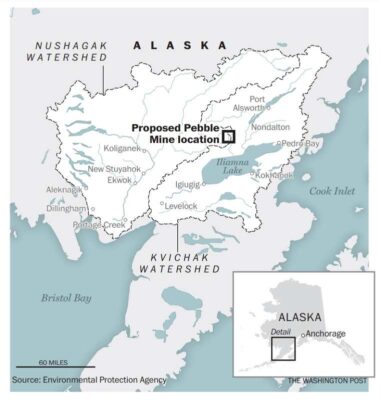
Sockeye salmon in Alaska.
13:52 JST, May 26, 2022
WASHINGTON – The Biden administration announced Wednesday that it will protect waters in Alaska that are home to one of the world’s biggest salmon spawning grounds, the culmination of a long-running dispute that pitted Alaska Natives against mining interests.

Bristol Bay
The proposal from the Environmental Protection Agency is a potentially fatal blow to a plan to mine in the Bristol Bay watershed for gold, copper and other valuable metals.
Bristol Bay, which sustains an annual run of 37.5 million sockeye salmon, helps support a $2 billion commercial fishing industry as well as a way of life for Alaska Natives, who have vigorously opposed the construction of the Pebble Mine.
The EPA’s action, if finalized, may finally put an end to a more than decade-long legal and political tussle over the fate of this corner of southern Alaska as President Joe Biden strives to protect a greater share of the nation’s wilderness.
“The Bristol Bay watershed is a shining example of how our nation’s waters are essential to healthy communities, vibrant ecosystems, and a thriving economy,” EPA Administrator Michael Regan said in a statement.
But the company behind the mine, Pebble Limited Partnership, said Wednesday that it will still work to secure a permit to dig up ore bearing gold, copper and molybdenum, used as an alloy in steel.
John Shively, the company’s chief executive, said it is “ironic” that the Biden administration would block a domestic source of copper, a crucial mineral for renewable energy, when it has set a goal of eliminating the nation’s contributions to global warming by the middle of the century.
“This is clearly a giant step backwards for the Biden Administration’s climate change goals,” he said in a statement.
Using a rarely used authority under the Clean Water Act to protect wetlands from being polluted with dumped waste, agency officials aim to ban the disposal of mining debris within the 308-square-mile footprint of the proposed project.
Over that ore deposit sit waters that teem with coho, chum and, most notably, sockeye salmon. The fish have been a source of food for southwest Alaska’s Indigenous peoples for generations and today attract big-spending fishing enthusiasts from around the world.
Alannah Hurley, executive director of United Tribes of Bristol Bay, a consortium of more than two dozen tribal governments, called the EPA’s announcement a “monumental step.”
“Our tribes have been asking for this for the last 12 years,” added Hurley, who is Yup’ik. But she warned that the federal government has come close to protecting these waters in the past, only to fall short.
“We’ve been here before,” she said.
Under President Barack Obama, the EPA moved to restrict mining in 2014. But it did not finalize the restrictions before he left office in 2017 as the agency battled litigation from the mining company.
At first, the Trump administration cleared the way for the firm to apply for a federal permit to mine.
But then, an unlikely alliance of Alaska Natives, environmentalists and anglers – including President Donald Trump’s son Donald Trump Jr. and Fox News host Tucker Carlson – came out in opposition. The release of secret recordings of company executives added to the pressure.
During Trump’s last months in office, his team ultimately torpedoed a key permit.
Pebble Limited Partnership argues that their hamstrung project would have created 850 direct jobs and generated more than $150 million in state and local taxes a year.
Shively, the chief executive, pointed to a U.S. Army Corps of Engineers conclusion in 2020 that the mine would have no “measurable effect” on fish populations, noting that foreign miners “simply do not have the same environmental standards as we do.”
But the current administration’s move to protect this wilderness was long expected, ever since Biden vowed to block the Pebble Mine during his run for president.
But with other mining claims nearby, many mine opponents are calling for Congress to pass more sweeping protections for the 40,000 square miles that make up the watershed.
“We’ll be playing whack-a-mole for a long time with the world’s best remaining salmon stronghold until we permanently protect this landscape,” said Chris Wood, head of the conservation group Trout Unlimited.
The EPA plans to hold hearings on the decision in June. And the public will be able to weigh in with written comments until July 5.
"News Services" POPULAR ARTICLE
-

American Playwright Jeremy O. Harris Arrested in Japan on Alleged Drug Smuggling
-

Japan’s Nikkei Stock Average as JGB Yields, Yen Rise on Rate-Hike Bets
-

Japan’s Nikkei Stock Average Licks Wounds after Selloff Sparked by BOJ Hike Bets (UPDATE 1)
-

Japanese Bond Yields Zoom, Stocks Slide as Rate Hike Looms
-

Japan’s Nikkei Stock Average Buoyed by Stable Yen; SoftBank’s Slide Caps Gains (UPDATE 1)
JN ACCESS RANKING
-

Keidanren Chairman Yoshinobu Tsutsui Visits Kashiwazaki-Kariwa Nuclear Power Plant; Inspects New Emergency Safety System
-

Imports of Rare Earths from China Facing Delays, May Be Caused by Deterioration of Japan-China Relations
-

University of Tokyo Professor Discusses Japanese Economic Security in Interview Ahead of Forum
-

Japan Pulls out of Vietnam Nuclear Project, Complicating Hanoi’s Power Plans
-

Govt Aims to Expand NISA Program Lineup, Abolish Age Restriction






















